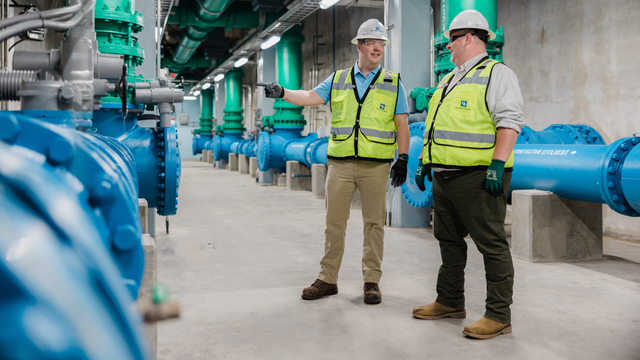Public agencies and utilities can tackle PFAS contamination faster with a data-driven model from Black & Veatch that improves the treatment technology selection process – shortening the project timeline.
Meeting PFAS regulations: How to stay ahead of compliance deadlines
Meeting the compliance deadline for PFOA and PFOS under the National Primary Drinking Water Rule presents a significant challenge. It stems from breakthrough, the point when PFAS concentration reaches a certain percentage of the maximum contaminant level (MCL) as the treatment media – such as granular activated carbon (GAC) or ion exchange resin – lose effectiveness and need to be replaced. The challenge is that media types have different breakthrough rates, and those rates vary depending on water chemistry, flow rates and the PFAS compounds being treated. Traditionally, pilots are conducted to select the right media given the specific circumstances. Piloting can take several months to become operational, followed by 6-9 months to observe meaningful breakthrough for GAC and more than a year for ion exchange. Altogether, the process can stretch to 18 months or more before the design process can begin.
Although the federal compliance deadline is expected to be extended from 2029 to 2031 and a new framework from AWWA and Black & Veatch is helping clarify piloting requirements, utilities remain under pressure to meet federal compliance deadlines. Even then, regardless of federal timelines, utilities must still comply with state-level regulations, which may be more stringent or have earlier deadlines. In addition, public concern about PFAS contamination continues to grow, and utilities are expected to respond proactively to the expectations of their customers. In any case, they need the ability to swiftly and confidently make a technology selection to move forward.
Developing an accelerated PFAS modeling solution
Although many models exist to predict the performance of PFAS treatment media, most have a significant flaw. Total Organic Carbon (TOC) can impair the performance of sorbent media, but does so in non-uniform and sometimes unexpected degrees based on the complex composition of compounds we lump together and measure as TOC. Without thorough characterization of TOC available in most datasets, models, particularly machine learning models lack the critical inputs they need to effectively recognize patterns in outcomes. Addressing the challenge, Black & Veatch developed a modeling approach that relies on performance data produced from the target water, allowing reliable predictions for that water, while significantly shortening the timeline for technology selection. The process began with a comprehensive data mining effort, pulling from peer-reviewed literature, technical reports and internal client data that informed the development of a the most accurate factors to include in the predictive model tailored to real-world conditions.
By observing the early breakthrough of short-chain PFAS compounds, which occurs within weeks to a few months, teams can use the model to extrapolate the breakthrough for longer-chain compounds like PFOA and PFOS using a framework called the Normalized Chain Length (NCL) approach. This empowers decision-making in just a few months, rather than a year or more.
Black & Veatch teams collaborated with leading PFAS researchers at North Carolina State University, including Dr. Detlef Knappe’s team, who are among the pioneers of adsorption research for treatment of trace organics in drinking water. While their ion exchange NCL model was published in peer-reviewed literature, Black & Veatch identified that the same approach could be applied for GAC and developed a complementary solution. Together, both groups are advancing the science of PFAS treatment and helping utilities make faster, data-driven decisions.
How predictive modeling cut PFAS pilot time by months
Black & Veatch was engaged by Orange Water and Sewer Authority (OWASA) in Carrboro, North Carolina to conduct a thorough evaluation of adsorptive technologies, including GAC, anion exchange, a hybrid of both, and FLUORO-SORB. The pilot was complex, requiring full-scale operational modifications to accommodate the testing.
Low total organic carbon (TOC) levels meant that the piloting process would have taken upwards of 9 months, but with BV’s predictive modeling, teams were able to interpret results before full breakthrough occurred. This enabled OWASA to confidently select a treatment technology months ahead of typical pilot schedule.
Predictive modeling delivers safer water and faster compliance
With pressure to remove PFAS contamination mounting, innovative solutions are essential to accelerate project timelines without compromising quality or confidence. In collaboration with North Carolina State University and Orange Water and Sewer Authority (OWASA), Black & Veatch has developed a predictive modeling approach that empowers utilities to make faster, data-driven decisions about PFAS treatment technologies.
By reducing the time required for piloting and technology selection, predictive modeling not only saves months in project schedules but also helps utilities stay ahead of evolving regulatory requirements. It is proving to be a powerful tool in the race toward safer, cleaner water and a more efficient path to compliance.






